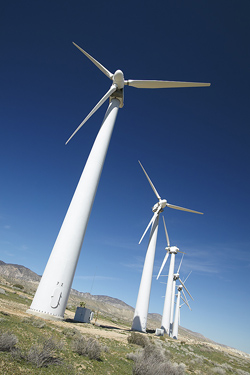Taxed power grid may get help from UMR researcher
Posted by news
As high heat and humidity push the demand for electricity to record levels this summer, a University of Missouri-Rolla professor is developing techniques to improve power grid reliability and prevent cascading outages during disturbances.
"If we operate the power grid the way we’ve been operating it the last 40 years, we’re going to have more failures," says Dr. Badrul Chowdhury, professor of electrical and computer engineering at UMR. "There’s no question about it. Unless we have new technologies and innovative operating strategies, we’re going to see a lot more outages and blackouts on the system."
With funding from the National Science Foundation, Chowdhury is investigating how wind farms, fuel cells, and other forms of distributed energy resources could help stabilize the system by remaining online even when major power lines and generating plants are lost.
 |
| Wind mills and other distributed energy resources could help stabilize the power grid by remaining online even when major power lines and generating plants shut down. |
"Wind mills and solar power plants are actually connected to the grid through an electronic device," Chowdhury explains. "Those electronic devices have automatic shut-offs when voltage and frequency deviate from the normal, thus creating a power deficit. My biggest concern is that we want to have the wind power and solar power when they are needed the most — during such disturbances, to prevent the grid from going into a tailspin."
More than 4,000 megawatts of wind power have been added to the U.S. power grid in the last four years, bringing the total to roughly 7,000 megawatts of total installed capacity.
"Wind power is still a very small fraction but it’s increasing," Chowdhury says. "Europe is way ahead of us in this game. In Denmark alone, 20 percent of total power needs are supplied by wind power. Germany and Spain are the next two countries that are establishing wind as a future power source."
In order to increase the amount of wind power on the power grid and keep it operating during disturbances, power storage devices will need to be added to the system. Aside from a handful of pumped-storage plants, like the Taum Sauk Plant near Lesterville, Mo., there has never been much electricity storage on the system. That’s mainly because the system hasn’t needed it due to the amount of rotating inertia in the system, Chowdhury says.
If we operate the power grid the way we’ve been operating it the last 40 years, we’re going to have more failures.
"As soon as you are flicking on your light switch, that power for your light bulb is being generated instantaneously at that point from some power plant," Chowdhury says. "When the amount of wind power and other distributed generation levels begin to increase significantly, there will be little inertia added to the system because they have to connected to the grid through electronic devices. Your only hope is to maintain enough storage to absorb the power fluctuations."
Chowdhury is currently investigating how superconducting magnetic energy storage devices (SMES) could help smooth out fluctuations on the power grid. The device uses the superconducting characteristics of low-temperature magnetic materials to produce intense magnetic fields to store energy.
"We’re looking at storage not only at the wind plant site but at various locations on the network," Chowdhury says. "We’re looking to see where the optimal locations would be because when you release the energy from a SMES unit, you can’t release it for hours. But if you can release 10 megawatts for a minute, the chances of stabilizing the system during a disturbance are very high."
Although it wouldn’t be possible to stabilize the entire Eastern grid, which runs from Kansas to the East Coast, Chowdhury says if the system was separated into different pockets, distributed generation and storage could help prevent cascading outages.
"People are putting the total cost of the August 2003 Northeast blackout in the range of $4 billion to $10 billion in damages," Chowdhury adds. "If you lose that much power for that long for that many cities — roughly 50 million people were affected — the cost of the outage is going to be pretty high. We probably won’t be able to eliminate outages completely, but we can actually reduce their impact."